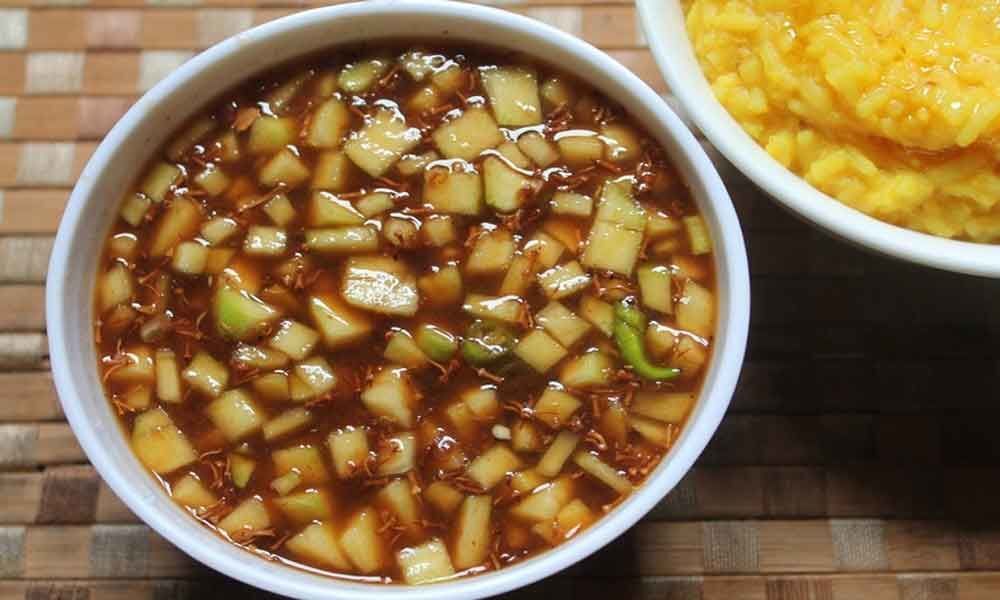Live
- Public Participation Key to Strengthening Democracy-Annamalai
- MLA Anirudh Reddy gets threat letter from Maoist
- "Awareness Program on Road Safety for Auto Drivers Held in Aija Town".
- MLA Bandla Krishna Mohan Reddy Inaugurates NPL Season-4 Cricket Tournament in Netivanipalli
- Rangoli Competitions Showcase Tradition and Creativity in Gadwal.
- "Vadde Obanna: A Revolutionary Hero’s Legacy Celebrated on His 218th Birth Anniversary".
- District Administration Accelerates Implementation of Welfare Schemes.
- Illegal Transportation of Gravel and Soil in Sankalmaddi Village Raises Concerns
- Weavers Celebrate Telangana CM Revanth Reddy’s Welfare Initiatives with Milk Ablution in Aiza.
- MLA Couple Attends Oath-Taking Ceremony of New Governing Body at Shri Shri Jamulamma Parashurama temple in Jammi chedu.
Just In
Ugadi Pachadi's rich medicinal values


Ugadi is the beginning of a new year for the people of the Telugu states and Karnataka. A new year is a new beginning for people. Many rituals are associated with the festival, but the most important ritual is preparing a special kind of chutney, known as the Ugadi Pachadi or Shadruchulu.
Hyderabad: Ugadi is the beginning of a new year for the people of the Telugu states and Karnataka. A new year is a new beginning for people. Many rituals are associated with the festival, but the most important ritual is preparing a special kind of chutney, known as the Ugadi Pachadi or Shadruchulu. It has an Ayurvedic quality of providing immunity against all types of illnesses that arise in summer. It is a tasty dish made with a lot of healthy ingredients.
Ayurveda says Ugadi Pachadi cleans away the vata, pita, kapha doshalu from one's body. Ugadi Pachadi is a balanced dish, as it contains nutritional values that purify the system and serve as prophylactics, i.e. protection against illnesses or diseases.
The pachadi has six different tastes assimilated in it: sweet, salty, bitter, tangy, spicy and sour. All of these tastes represent the different facets of life, such as happiness, disgust, bitterness, surprise, anger and fear, respectively.
Apart from being a tasty dish, the Ugadi Pachadi is significant in many other ways. In Telangana, the preparation is made less thickly compared to other states. The dish also has medicinal values and works as a coolant for the ensuing hot summer.
Bitterness
The bitter taste of the Pachadi comes from the neem flowers. The taste represents the unhappy moments of life. Bitter moments are also a part of life, and so it should not be forgotten.
Ayurveda prescribes neem for curing 35 kinds of diseases. The worms and germs that enter the body will be killed by the use of neem. Medicinal benefits are available in the neem leaves, flowers, fruits, seeds, roots, bark and glue.
Sweetness
The sweet taste comes from the jaggery. The sweet taste is the happy moments of life. Jiggery protects defense mechanism.
Jaggery
It detoxifies the liver by flushing out harmful toxins from the body. It is loaded with anti oxidants selenium and zinc, which prevents the free radical damage and increases the immunity of the body against infections.
Tangy
The tangy taste of the Pachadi is from the unripe mango. Ugadi marks the beginning of the mango season. Hence mango represents the surprise element of our life and that a person should always be prepared for it. Unripe mango pieces drenched in neem sauce heal intestinal wounds and bleeding. They prevent sunstroke.
Raw Mangoes
They prevent dehydration, and also helps in improving the blood circulation; Vitamin C helps in improving immunity. Raw mango provides relief from acidity and chest burn. It increases the secretion of bile and cleans the intestine of bacterial infections and as well improves the elasticity of blood vessels and helps in the formation of new blood vessels. In short, mangoes act as tummy cleansers.
Spicy
The spicy taste comes from the red chilli powder. It represents the angry moments in life. Chilli powder improves immunity and also fights with any skin infections.
Salty
The salt represents the taste of life. The salty moments are necessary to make our lives interesting. The salt prevents rheumatic disease and sluggishness. Salt prevents dehydration and also balances the lost sodium through excess sweating during the hot heat.
Sour
Tamarind adds the sour taste to the Pachadi. It represents the sour moments of life, which along with other flavours make our lives worth living. Tamarind destroys a thousand diseases. It is an excellent cleanser and also helps in the absorption of minerals. Tamarind helps in digestion and eases the stomach from discomfort. It reduces inflammation throughout the body, improves skin condition and lowers cholesterol.

© 2025 Hyderabad Media House Limited/The Hans India. All rights reserved. Powered by hocalwire.com






